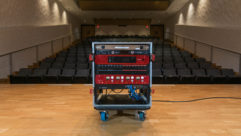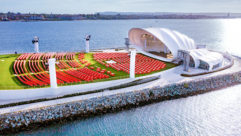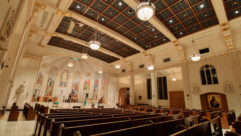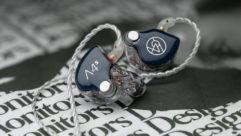Minds Wide Open
Apr 1, 2001 12:00 PM,
Cathy Ross
The University of Minnesota, Crookston continues to help set thestandard for technologically advanced learning and was ranked oneof “America’s Most Wired Colleges” by Yahoo!Internet Life magazine in 2000.
MORE THAN TWO DECADES AGO, THE state of Minnesota began a grassroots effort to network its educational resources. This became thehuge project: to wire the entire state’s educational system.
Today, all public universities, colleges, K-12 school districtsand libraries are connected to the same interactive videoconferencing and distance learning system. Though the pioneers ofthis project could not have imagined it then, the system today cantake students through guided rainforest tours and even to NASA.
The pursuit of this educational network began with collegepresidents and school superintendents trying to improve thediversity of academic offerings and increase access by sharingresources. With outstanding funding and support from the statelegislature, it has evolved into the Learning Network ofMinnesota.
A HISTORICAL LOOK
In 1990, four northwest Minnesota College presidents atNorthwest Technical College, Thief River Falls Technical College,Northland Community College and the University of Minnesota,Crookston, formed a partnership. They hired network coordinatorJeff Sinks to assist them in implementing their vision in thenorthwest corner of Minnesota. Jeff has worked more than 11 years,with the help of other regional coordinators and educationalleaders, to make the vision of worldwide access a reality for hisportion of the state. The Northwest Educational Technology Systemwas originally comprised of four universities connected via analogFM signals over leased fiber lines. The signals were all routed andcontrolled through one hub location at the NETS office, housed atthe University of Minnesota in Crookston.
In 1993, several K-12 networks near Thief River Falls connectedto Northland Community Technical College, allowing them to shareall existing connectivity to the NETS and UMC systems. In 1994,NETS grew to 10 college campuses. Under leadership and guidancefrom the board of directors, these 10 universities made a firmcommitment to this aggressive distance learning venture. The NETSoffice at UMC remained the control center for all 10 universities,and hubs were created at Northwest Technical College in Wadena andNorthland Community Technical College in Thief River Falls. Thesehubs still receive and distribute all signals from the 10universities.
Also in 1994, under the guidance of Steve Jatczak, NWLINKS (theK-12 school and library partnership in Northwest Minnesota) cameonline with 74 sites using ISDN technology and existing, leasedfiber FM, uncompressed digital and H.320 technologies. Thispartnership between NETS and NWLINKS strengthened both networksimmeasurably but also provided a significant challenge. To maintainseamless communication between such diverse platforms, all signalswere taken down to baseband at each site and at the hub locations.This removed all incompatibility issues.
The conversion to digital began in 2000. NETS converted most ofits FM over fiber infrastructure to an uncompressed digitalplatform. Essentially, two technologies are used. The overwhelmingmajority is Force gear, an uncompressed digital signal on a 3.1-gigbandwidth platform that is similar to most cable television. Only asmall part of the network still uses fiber analog FM signals, andall sites will be converted to digital by the end of 2001. At thattime, NETS will be fully digitized on the Force platform. Sitesthat were originally connected through analog FM networks now hitthe main hubs as uncompressed digital or compressed digital. Someare ISDN platforms, so NETS installed ISDN gateway codecs at hubsites to interface with them.
While NETS was growing, so were five other major networks in thestate, Northeast Alliance for Telecommunications, Central MinnesotaDistance Learning Network, Metropolitan EducationalTelecommunications Network, Southwest/West Central Higher EducationOrganization for Telecommunications and the interactive televisionnetwork, COMET. Gateways between NETS and these five organizationswere established in 1994 through the efforts of the MinnesotaEducation Technology Council and the Higher Education ServicesOffice. This was accomplished primarily through H.320 linksprovided by InterTechnologies, a division of the MinnesotaDepartment of Administration.
THE NETS SYSTEM TODAY
Today NETS provides interactive A/V gateways that allow collegesin northwestern Minnesota non-dedicated, worldwide access to allcolleges, K-12 schools and libraries in the state. Audio and videosources from the 10 NETS universities travel over leased fiber tothe Wadena and Thief River Falls hubs. The hubs are really theultimate signal conversion and distribution centers.
The signals from the universities are encoded from the host siteto enable travel over the leased fiber, decoded before being routedthrough two AutoPatch Epica-256 128 × 128 composite video andmono audio baseband routers, recoded and sent to the receivinglocation, and finally decoded again to the suitable format for therecipient equipment. All routing is at baseband level, whicheliminates compatibility problems.
The hub sites also accept ISDN and H.320 signals from K-12schools and even more distant gateway locations via gateway codecsat each site. Signals from these gateways are sent to the hublocations as well. The signals then go to codecs: it might be ISDN,H.320 or a decoder/encoder for some independent network. Bybasebanding signals, we can just hop between gateways without aproblem.
INTERFACING CAPABILITIES
By basebanding signals from FM analog networks or uncompresseddigital independent networks and in putting the signals into ourhub router, we can then tie outputs to modulators, codecs orencoders that feed off that network. In this way, we provideservice not only between the universities and the other networks,but also between little networks, allowing them to bridge to eachother. If we need to go to the ISDN or the H.320 world, we basebandin and out of the codec. Many types of codecs are used:Picturetell, CLIs, Tanbergs and Grass Valley.
A sample NETS rack may include:
- Quad processors from Panasonic
- Audio mixers from Shure and others
- Echo cancellers and time-base correctors from ASPI
- Optical receivers and transmitters from Comlux and GrassValley
- A/V encoders and decoders from Comlux and Grass Valley
- Optical receivers, modulators and demodulators fromPhilips
- Multiplexer from Penril
- Deskport Fast+ Modems from Microcomm
- Codecs from British Telecom, Tanberg, Picturetel, Litton andCLI
“People are looking for the platform this is on tochange,” says Jeff Sinks. “We expect the state to moveforward to a solid H.323 platform with IP video. Synchronous videocommunication will never go away — it will just go up.Whether it’s on 323 or whatever platforms you want to think aboutfor tomorrow, it’s just going to go up.”
All school sites can connect to the system at any time. ISDNgateway codec lines further allow students on the system toparticipate in global activities such as the interactive scienceclasses offered by NASA in Houston. Adults attend interactivecollege courses at the high schools and public libraries in theevening, and the system has even provided emergency communicationbetween the communities in Minnesota when traditional broadcastsystems became unavailable due to catastrophic floods in the RedRiver Valley in 1997.
CONTROL
The office for remote control of the two hub sites, from theNETS operations center at UMC, uses leased lines between computersin its own building and the equipment at Wadena and Thief RiverFalls, 150 miles away. Given the heavy level of site activity (NETSexperienced more than 20,000 hours of activity last year),automated signal routing is essential. Members book activities intothe NETS scheduling software, which generates time-based eventreports that integrate easily with the AutoPatch schedulingsoftware and A/V routers. Then, the course schedule is loaded forthe entire semester on laptops at Crookston, and the routerautomatically distributes the signals.
For backup, the network controls are run over separate leaseddata lines so that traffic can continue from the hubs even if a legof the fiber goes down. Blocked transmission is contained to onlythose sites on the damaged fiber leg while the rest workunhindered.
Three staff members man the control office. They providetechnical support, maintain the collegiate database, helpcollegiate programming and handle requests from K-12 and librarymembers.
THE CLASSROOMS
Although not all classroom systems and connections are the same,one of the possible scenarios is as follows: Two classrooms shareone instructor. The primary classroom has one camera on theinstructor, another on the instructor’s white board or overhead,and a third on the students. The secondary classroom is equippedwith a camera on the students. The primary classroom also has fourmonitors. One monitor is for the instructor to view what the remotestudents will see; and the remaining three can be used to view thestudents in the remote classrooms. A small switcher located at theteaching console allows the instructor to select which camera viewthe remote students will see. Voice activated microphones areplaced throughout both classrooms allowing the students to askquestions and interact remotely.
University professors can teach in their own classrooms and inmany remote sites simultaneously. When more classes are viewing theinstructor than the number of monitors the instructor can use toview the classes, the system uses voice activated switching orcontinuous presence split screening. Multipoint control units areused to accomplish the video-follow-audio voice activatedswitching. The video defaults to follow the audio in whicheverclassroom the person is speaking.
The cameras in the classroom have independent controls and areoperated at each site, not remotely. The cameras themselves aretypically consumer quality. Broadcast quality cameras proved tomake little difference without high-definition lighting, which wasomitted in order to keep classrooms comfortable. The professor,librarian or technical person takes care of the technicaloperations in each classroom. Typically, this just involves turningthe equipment on, doing an audio check and hooking up laptops forpresentations if needed.
The classroom monitors are a variety of inexpensive, standard20-inch, 25-inch, 27-inch and 30-inch television monitors, althoughsome sites do have 50- or 60-inch monitors. A large variety ofbrands is used.
CONCLUSION
Minnesota has benefited greatly (in both cost efficiency andpersonal contact) from its interactive distance-learning system.Small communities with extremely small schools can now providestudents specialized instructors for required basics. Theuniversities, by sharing their excellent teaching staff, can usethese experts’ full potential. Thanks to the vision of educationalCEOs at the grass roots level, leadership and funding from theMinnesota Higher Education Services Department and the MinnesotaLegislature, and support from Minnesota Senators Stumpf and Kelley,NETS and its partners have captured a wealth of knowledge andspread its resources to the most remote one-classroom schools inthe state. NETS has unlocked the world of learning for allMinnesota students.
Cathy Ross is marketing director at AutoPatch. She can bereached at [email protected].Cathy would like to thank Robert Oaks, Duff Johnson, Pat Saunders,Rick Wise and Jeff Sinks for their assistance in writing thisarticle.
FOR MORE INFORMATION
ASPI Digital
www.aspi.com
Circle 260 on Reader Service Card
AutoPatch
www.autopatch.com
Circle 261 on Reader Service Card
British Telecom
www.bt.com
Circle 262 on Reader Service Card
CLI
Circle 263 on Reader Service Card
Comlux
Circle 264 on Reader Service Card
Grass Valley
www.grassvalleygroup.com
Circle 265 on Reader Service Card
Litton
www.litton.com
Circle 266 on Reader Service Card
Microcomm
www.microcomm.co.nz
Circle 267 on Reader Service Card
Panasonic
www.panasonic.com
Circle 268 on Reader Service Card
Philips
www.philips.com
Circle 269 on Reader Service Card
Pioneer
www.pioneerelectronics.com
Circle 270 on Reader Service Card
Shure
www.shure.com
Circle 271 on Reader Service Card
Tanberg
www.nrhf.no/nrhf-TB.html
Circle 272 on Reader Service Card










